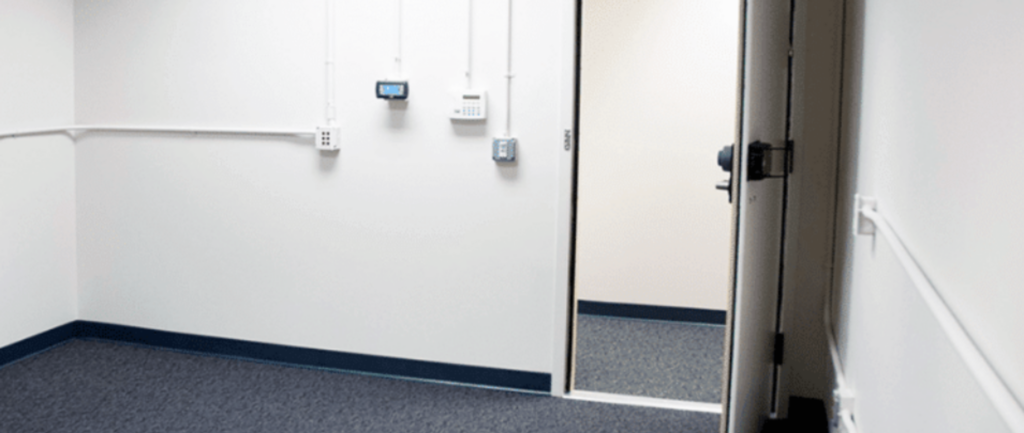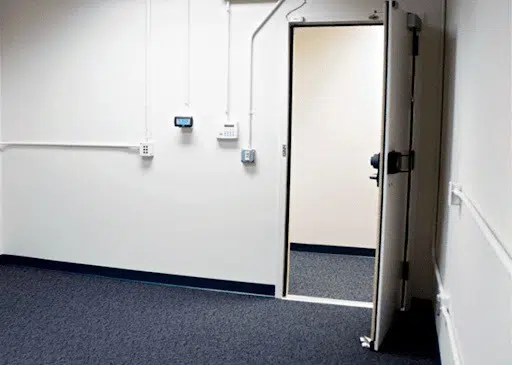
Unveiling SCIF Room Design: Protecting Intelligence and Security
It is important to consider SCIF room design standards when trying to understand high-security openings. The protection and strengthening of defenses and radio frequency (RF) environments is crucial in modern-day operations. Otherwise, a business runs the risk of compromising intelligence, security, or even violating strict compliance regulations.
What are SCIF Room & Door Specifications?
In case you’re wondering what SCIF stands for, you’ve come to the right place. Not only will we define SCIF in general, but we’ll also dive deeper into it, taking a closer look at SCIF RF shielding, SCIF room design, SCIF doors, hardware, and other specifications that you need to avoid.
What is a SCIF Room?

SCIFs can be permanent or temporary, and can be set up in government buildings, on ships, private residences of officials, hotel rooms and other places of necessity for officials when traveling. SCIF rooms in U.S. facilities around the world follow the same standards laid out by the office of the United States Director of National Intelligence.
What Are the Technical Specifications for Sensitive Compartmented Information Facilities (SCIF)?
DCID 6/9 is the “Physical Security Standards for Sensitive Compartmented Information Facilities” Manual, as approved by the Director of Central Intelligence (DCI). The current edition is dated 18 November 2002.
Basic requirements as per DCID 6/9:
- It must be alarmed with an electronic intrusion detection system.
- Permanent dry wall construction is required.
- Sensitive information must be stored in general service administration (GSA) approved security containers for “closed storage classifications”.
- There must be a response force capable of responding to an alarm within 15 minutes after announcement. In addition, there must be a reserve response force available to assist initial responders.
For more details, view the technical specifications for construction and management of SCIF rooms as per DCID 6/9.
What about SCIF Doors?
SCIF room designs are basically secure rooms, constructed using materials that block espionage attempts and keep sensitive information secret. Since the door opening is the only component of the room that opens and closes, it is the most difficult part to secure. Although the door is only open for short periods of time, spies may be capable of detecting patterns through hours of recordings. Acoustic steel doors, frames as well as wood acoustic doors help limit the amount of sound transmission from one side of the assembly to the other. This makes them an essential component of any SCIF room.
SCIF Door Requirements for Entrances & Exits:
- Primary entrance doors into SCIFs shall be limited to one. If circumstances require more than one entrance, this must be approved by the CSA (Cognizant Security Authority). In cases where local fire regulations are more stringent, they will be complied with. All perimeter SCIF doors must be closed and secured when not in use.
- All SCIF primary entrance doors must be equipped with an automatic door closer, a GSA-approved combination lock and an access control device.
- Solid wood core door, a minimum of 1-3/4 inches thick or, 16-gauge metal cladding over wood, a minimum of 1-3/4 inches thick or, metal fire or acoustical protection doors, a minimum of 1-3/4 inches thick required.
- Specifications of doors, combination locks, access control devices and other related hardware may be obtained from the CSA.
- SCIF doors are recommended to be three feet wide, single, swing, flush face doors. These doors should be without louvers, unusual undercuts, vision lights, transoms, or side lights. Door pairs and exterior assemblies should also be avoided.
- SCIF door assemblies are recommended to match the general building door and frame style, size, appearance, color, and finish to the extent possible. This includes paint finishes as well as wood door species, grain, and stain.
View the full list of Entry, Exit and Access SCIF Door Requirements for more details.
What Are SCIF Door Hardware Types and Standards?
The two most referenced documents for SCIF design are ICD/ICS-705, Technical Specification for Construction and Management of Sensitive Compartmented Information Facilities, [1] and NSA 94-106 [2]. It has been our experience that these documents are often referenced interchangeably or in conjunction with each other. In some cases, project documents will indicate that a facility has been designed to meet NSA 94-106 as identified in ICD/ICS-705. This is problematic as ICD/ICS-705 does not reference NSA 94-106, nor is ICD/ICS-705 intended to meet the requirements set forth in NSA 94-106. This article will analyze the purpose of ICD/ICS-705 and NSA 94-106, as it pertains to RF shielding and highlight some of the differences between the two standards.
Hardware Types:
These requirements for code compliance were carried forward into the 2019 edition of the federal specification (FF-L-2890C), which is called Lock Extensions (Pedestrian Door Lock Assembly Preassembled, Panic, and Auxiliary Deadbolt). This 30-page standard details the types of locks required for primary and secondary doors, which are divided into 10 hardware types.
HARDWARE FOR PRIMARY ENTRANCE DOORS:
- Type I – Lockset (PDPL) with mechanical or electronic stand-alone access control (i.e. keypad with a minimum 4-digit combination) – ANSI/BHMA A156.2 Grade 1, with electromechanical combination lock (FF-L-2740)
- Type II – Lockset (PDPL) with the capability of being used with building access control system, fail secure – ANSI/BHMA A156.2 Grade 1, with electromechanical combination lock (FF-L-2740)
- Type III – Panic hardware/fire exit hardware (PDLAP), rim type, with mechanical or electronic stand-alone access control (i.e., keypad with a minimum 4-digit combination) – ANSI/BHMA A156.3 Grade 1 Type I, with electromechanical combination lock (FF-L-2740)
- Type IV – Panic hardware/fire exit hardware (PDLAP), rim type, with the capability of being used with the building access control system, fail secure – ANSI/BHMA A156.3 Grade 1 Type I, with electromechanical combination lock (FF-L-2740)
- Type V – Deadbolt (ADB) – ANSI/BHMA A156.36 Grade 1, with electromechanical combination lock (FF-L-2740) and escape mechanism extension with an automatic life safety device with keyed reset function
- Type VI – Deadbolt (ADB) – ANSI/BHMA A156.36 Grade 1, with electromechanical combination lock (FF-L-2740) and escape mechanism extension with a manually operated life safety device.
HARDWARE FOR SECONDARY ENTRANCE DOORS:
- Type VII – Lockset (PDPL) with the capability of being used with building access control system, fail secure – ANSI/BHMA A156.2 Grade 1, with integral deadbolt and thumb turn
- Type VIII – Panic hardware/fire exit hardware (PDLAP), rim type, with the capability of being used with the building access control system, fail secure – ANSI/BHMA A156.3 Grade 1 Type I, with integral deadbolt and thumb turn.
HARDWARE FOR EMERGENCY EGRESS- ONLY DOORS:
- Type IX – Lockset (PDPL) with integral deadbolt – ANSI/BHMA A156.2 Grade 1
- Type X – Panic hardware/fire exit hardware (PDLAP), rim type, with integral deadbolt – ANSI/BHMA A156.3 Grade 1 Type I
Hardware types V and VI are intended to be used on doors that are not part of a required egress route. They are not required to be operable with one hand and a single motion to unlatch the door for egress. These locks would typically be used on unoccupied rooms such as telecommunications closets. The remaining hardware types (I through IV and VII – X) are required to comply with the codes and standards referenced above, in addition to the applicable BHMA standards.
What is SCIF RF Shielding?
In Sensitive Compartmented Information Facility (SCIF) rooms, utilizing an RF shielded door as an information vestibule adds an extra layer of protection. SCIF RF shielding adds an extra layer of protection to electronic devices against radio frequency interference issues that would have an impact on their performance and functionality. RF shielded doors have emerged as an ideal option for the outer opening of an information vestibule, due to the door’s hybrid capabilities of having an STC 50 rating along with shielding properties. SCIF rooms often have acoustic security requirements including denying aural access to classified information. While schools, boardrooms, or performing arts centers recommend STC 40 to 50 ratings, a SCIF-compliant door must meet the ICD/ICS 705 standard determined by the Department of Defense in the United States. It is typically STC rated at 50 or 55.
While SCIFs are complex and highly technical facilities, successful projects are about more than just the physical design and requirements. It is important to have a trusted design partner and manufacturer who understands not only your needs as a client but also how to work with sensitive and confidential projects, all while interpreting and confirming your requirements and standards. For information on how we can help at AMBICO, feel free to contact us today or request a quote. We look forward to ensuring your next project meets established SCIF room requirements with our acoustic door assemblies.



